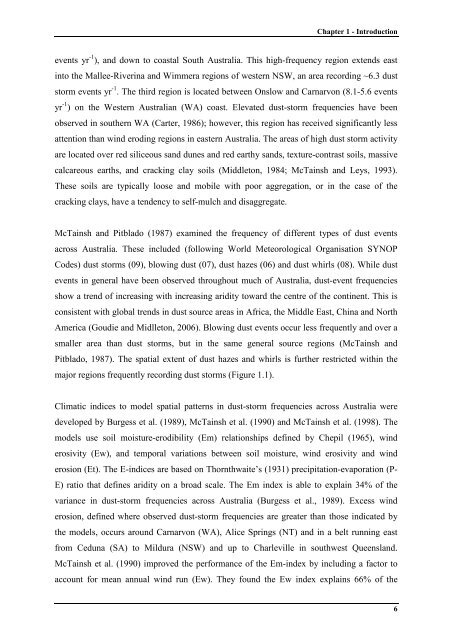Wind Erosion in Western Queensland Australia
Modelling Land Susceptibility to Wind Erosion in Western ... - Ninti One
Modelling Land Susceptibility to Wind Erosion in Western ... - Ninti One
You also want an ePaper? Increase the reach of your titles
YUMPU automatically turns print PDFs into web optimized ePapers that Google loves.
Chapter 1 - Introductionevents yr -1 ), and down to coastal South <strong>Australia</strong>. This high-frequency region extends east<strong>in</strong>to the Mallee-River<strong>in</strong>a and Wimmera regions of western NSW, an area record<strong>in</strong>g ~6.3 duststorm events yr -1 . The third region is located between Onslow and Carnarvon (8.1-5.6 eventsyr -1 ) on the <strong>Western</strong> <strong>Australia</strong>n (WA) coast. Elevated dust-storm frequencies have beenobserved <strong>in</strong> southern WA (Carter, 1986); however, this region has received significantly lessattention than w<strong>in</strong>d erod<strong>in</strong>g regions <strong>in</strong> eastern <strong>Australia</strong>. The areas of high dust storm activityare located over red siliceous sand dunes and red earthy sands, texture-contrast soils, massivecalcareous earths, and crack<strong>in</strong>g clay soils (Middleton, 1984; McTa<strong>in</strong>sh and Leys, 1993).These soils are typically loose and mobile with poor aggregation, or <strong>in</strong> the case of thecrack<strong>in</strong>g clays, have a tendency to self-mulch and disaggregate.McTa<strong>in</strong>sh and Pitblado (1987) exam<strong>in</strong>ed the frequency of different types of dust eventsacross <strong>Australia</strong>. These <strong>in</strong>cluded (follow<strong>in</strong>g World Meteorological Organisation SYNOPCodes) dust storms (09), blow<strong>in</strong>g dust (07), dust hazes (06) and dust whirls (08). While dustevents <strong>in</strong> general have been observed throughout much of <strong>Australia</strong>, dust-event frequenciesshow a trend of <strong>in</strong>creas<strong>in</strong>g with <strong>in</strong>creas<strong>in</strong>g aridity toward the centre of the cont<strong>in</strong>ent. This isconsistent with global trends <strong>in</strong> dust source areas <strong>in</strong> Africa, the Middle East, Ch<strong>in</strong>a and NorthAmerica (Goudie and Midlleton, 2006). Blow<strong>in</strong>g dust events occur less frequently and over asmaller area than dust storms, but <strong>in</strong> the same general source regions (McTa<strong>in</strong>sh andPitblado, 1987). The spatial extent of dust hazes and whirls is further restricted with<strong>in</strong> themajor regions frequently record<strong>in</strong>g dust storms (Figure 1.1).Climatic <strong>in</strong>dices to model spatial patterns <strong>in</strong> dust-storm frequencies across <strong>Australia</strong> weredeveloped by Burgess et al. (1989), McTa<strong>in</strong>sh et al. (1990) and McTa<strong>in</strong>sh et al. (1998). Themodels use soil moisture-erodibility (Em) relationships def<strong>in</strong>ed by Chepil (1965), w<strong>in</strong>derosivity (Ew), and temporal variations between soil moisture, w<strong>in</strong>d erosivity and w<strong>in</strong>derosion (Et). The E-<strong>in</strong>dices are based on Thornthwaite’s (1931) precipitation-evaporation (P-E) ratio that def<strong>in</strong>es aridity on a broad scale. The Em <strong>in</strong>dex is able to expla<strong>in</strong> 34% of thevariance <strong>in</strong> dust-storm frequencies across <strong>Australia</strong> (Burgess et al., 1989). Excess w<strong>in</strong>derosion, def<strong>in</strong>ed where observed dust-storm frequencies are greater than those <strong>in</strong>dicated bythe models, occurs around Carnarvon (WA), Alice Spr<strong>in</strong>gs (NT) and <strong>in</strong> a belt runn<strong>in</strong>g eastfrom Ceduna (SA) to Mildura (NSW) and up to Charleville <strong>in</strong> southwest <strong>Queensland</strong>.McTa<strong>in</strong>sh et al. (1990) improved the performance of the Em-<strong>in</strong>dex by <strong>in</strong>clud<strong>in</strong>g a factor toaccount for mean annual w<strong>in</strong>d run (Ew). They found the Ew <strong>in</strong>dex expla<strong>in</strong>s 66% of the6
















